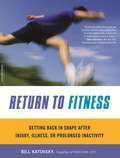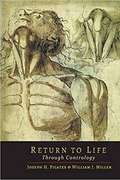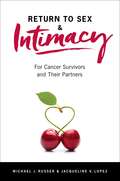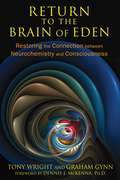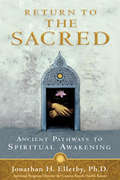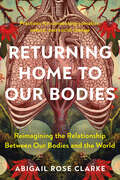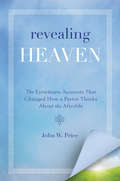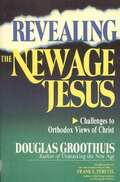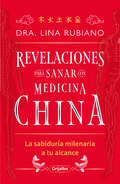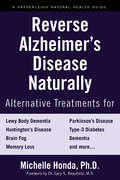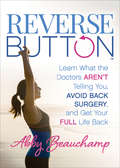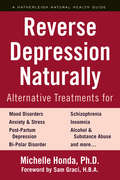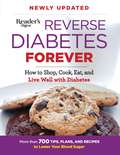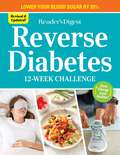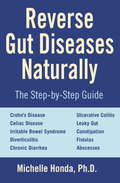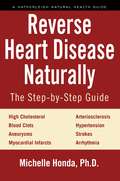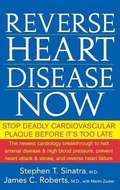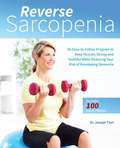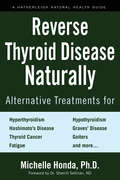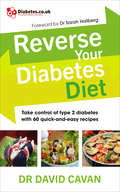- Table View
- List View
Return to Fitness
by Bill KatovskyFrom the coauthor of "Bike for Life" and founder of "Tri-Athlete Magazine," comes an indispensable guide to regaining health and fitness after illness, inactivity, or injury
Return to Life Through Contrology
by Joseph H. Pilates William John Miller2014 Reprint of 1945 Edition. Full facsimile of the original edition. Not reproduced with Optical Recognition Software. <p><p> "Return to Life Through Contrology" is essential Pilates reading. In this one small book, Joseph Pilates conveys the breadth and power of the Pilates method. Covering philosophy and technique, Pilates outlines the effective and enduring approach to whole body health that is one of the fastest growing fitness trends in the world. "Contrology" related to encouraging the use of the mind to control muscles, focusing attention on core postural muscles that help keep the body balanced and provide support for the spine. In particular, Pilates exercises teach awareness of breath and of alignment of the spine, and strengthen the deep torso and abdominal muscles.
Return to Sex and Intimacy: For Cancer Survivors and Their Partners
by Michael Russer Jacqueline LopezWhat can a fully impotent, chemically castrated, survivor of two cancers and his post-menopausal partner possibly share about sex, intimacy and relationships? Everything! - including a world of extraordinary emotional, sexual and spiritual intimacy most couples cannot even fathom possible. <p><p> Whether your relationship is impacted by impotence, cancer or not, this groundbreaking book is your proven guide to profound relationship fulfillment on all levels that only gets better over time, regardless of circumstances.
Return to the Brain of Eden: Restoring the Connection between Neurochemistry and Consciousness
by Tony Wright Dennis J. Mckenna Graham GynnAn exploration of our fall from the pinnacle of human evolution 200,000 years ago and how we can begin our return • Explores recent neurological and psychological research on the brain and the role of plant biochemistry in human brain expansion • Explains how humanity’s prehistoric diet change led to a neurodegenerative condition characterized by aggression and a fearful perception of the world • Outlines a strategy of raw foods, tantric sexuality, shamanic practices, and entheogens to reverse our mental degeneration and restore our advanced abilities Over a period of a million years the human brain expanded at an increasingly rapid rate, and then, 200,000 years ago, the expansion abruptly stopped. Modern science has overlooked this in order to maintain that we are at the pinnacle of our evolution. However, the halt in brain expansion explains not only recently uncovered anomalies within the human brain but also the global traditions of an earthly paradise lost and of humanity’s degeneration from our original state of perpetual wonder and joy. Drawing on more than 20 years of research, authors Tony Wright and Graham Gynn explore how our modern brains are performing far below their potential and how we can unlock our higher abilities and return to the euphoria of Eden. They explain how for millions of years early forest-dwelling humans were primarily consuming the hormone-rich sex organs of plants--fruit--each containing a highly complex biochemical cocktail evolved to influence DNA transcription, rapid brain development, and elevated neural and pineal gland activity. Citing recent neurological and psychological studies, the authors explain how the loss of our symbiotic fruit-based diet led to a progressive neurodegenerative condition characterized by aggressive behaviors, a fearful perception of the world, and the suppression of higher artistic, mathematical, and spiritual abilities. The authors show how many shamanic and spiritual traditions were developed to counteract our decline. They outline a strategy of raw foods, tantric sexuality, shamanic practices, and entheogen use to reverse our degeneration, restore our connection with the plant world, and regain the bliss and peace of the brain of Eden.
Return to the Sacred: Ancient Pathways To Spiritual Awakening
by Jonathan EllerbyAre you looking for inner peace? Do you seek a deeper understanding of yourself and the spiritual world? Have you followed the popular prescriptions for enlightenment and still found yourself unsatisfied? <P><P>Return to The Sacred is a fascinating guide that will help you understand the importance of spiritual practice and the great diversity of paths that are available to you. This is a book that does more than provide philosophy and inspiration; it gives you the freedom to find a path that works for you and the knowledge to experience the answers for yourself. You’ll learn about the time-tested tools of spiritual growth that will help you discover extraordinary depths of wisdom, power, and peace. <P><P> Return to The Sacred will introduce you to the 12 Master Paths and Practices that have transformed the lives of countless saints, mystics, masters, and sages since the beginning of history. In this book, you’ll find what you need to discover your spiritual personality and choose the path that will lead you toward the realization of boundless joy and a lifelong journey of meaning. Jonathan Ellerby, Ph.D., weaves threads of personal growth and comparative religion into captivating true tales of spiritual adventures with teachers and healers around the world. <P><P>Through colorful stories and clear reflections, he presents a perspective that reveals the rewards of spiritual practice, and a realistic understanding of the deep commitments and challenging steps along the way. Return to The Sacred is an inspiring journey around the globe and into the furthest reaches of Spirit.
Returning Home to Our Bodies: Reimagining the Relationship Between Our Bodies and the World--Practices for connecting somatics, nature, and social change
by Abigail Rose ClarkeFor readers of adrienne maree brown, Staci K. Haines, and Robin Wall KimmererA body-based healing model that interrogates what we&’ve been wrongly taught about hierarchies of nature and the body—and pushes back against the white supremacy, colonialism, patriarchy, and capitalism embedded in modern embodiment practices.Pushing back against a consumerist, pleasure-centric somatics industry that privileges product over process, Abigail Rose Clarke reminds us that truly meaningful embodiment practice nurtures our relationships among self, nature, and community.Combining the rigor of the scientific method with the poetry and lyricism of movement and somatic studies, Clarke&’s somatic learning system—The Embodied Life Method—centers the body as a guide through today&’s most seemingly intractable social and environmental challenges, reclaiming the body as a source of liberatory comfort in times of great uncertainty and yet, possibility. With tools and practices to help us better understand and dismantle the many ways our bodies are weaponized to serve domination systems, topics covered include:Harnessing the vitality of curiosity and experimentationUsing nature as a guide to possibilityEmbracing the necessity of differenceExposing the lie of universal isolationDismantling the fallacy of hierarchyUncovering the truth of endless capacityAwe as a driving force for transformationWith methods honed over decades of inquiry, teaching, and practice, Returning Home to Our Bodies provides a lucid, body-based model of healing and restoration—one that imagines a world beyond systems of domination, marginalization, and isolation to nurture embodied, whole-community liberation.
Returning to the Source: Han Dynasty Medical Classics in Modern Clinical Practice
by Professor Z'Ev Rosenberg Ken Rose Dr Sabine Wilms Blair ThornleyChinese Medicine constantly refers back to its sources in order to initiate the new. Its source code is in the Han Dynasty medical classics, and in this handbook esteemed practitioner and educator Professor Z'ev Rosenberg shares the knowledge from his study of these classic texts and his experiences treating difficult cases. In the tradition of the scholar-physician commentaries, Z'ev Rosenberg comments on the Simple Questions that introduce the core principles of the Inner Canon; explaining how these inform his methodology of diagnosis and advising on how biomedical diseases can be retranslated into sophisticated Chinese medical diagnoses including patterns of differentiation, sequential diagnosis, synchronicity, season, climate and environment. He discusses how Chinese medicine can use unique diagnostic parameters to rebalance the landscape and chronobiology of the body and address the greatest clinical challenges of our time, including the contemporary epidemic of autoimmune disorders.
Revealing Heaven: The Eyewitness Accounts That Changed How a Pastor Thinks About the Afterlife
by John W. PriceIn Revealing Heaven, Reverend John W. Price makes the case for how near-death experiences can be gifts from God and are fully compatible with Christian spirituality and the Bible. As a pastor open to near-death experiences, he has heard more than 200 personal accounts of this phenomena.Todd Burpo's bestelling book Heaven Is for Real, the story of a young child’s near-death experience, has validated the existence of heaven and of God for many. Yet there are Christians who remain uncomfortable with the idea of near-death experiences; they wonder if these events are in line with the Bible and Christian teaching.In Revealing Heaven: The Christian Case for Near-Death Experiences, Reverend Price shares compelling testimonies that prove that Christians can not only trust near-death experiences as valid and consistent with Biblical teaching, but he demonstrates how they can help us understand death, grief, and what happens after this life is over, and provides ample reasons for us to be open to these amazing stories and to hope for what we’ve always dreamed about.
Revealing The New Age Jesus: Challenges To Orthodox Views Of Christ
by Douglas GroothuisThe New Age movement spreads more and more confusing ideas about the identity of Jesus Christ. Now Douglas Groothuis examines the claims of leading New Age thinkers, comparing their picture of Jesus with the teachings of biblical Christianity. Meeting New Age beliefs about Jesus head-on, he demonstrates how the Bible gives a trustworthy record of the man who forever changed world history. This compelling book is the first to consider both Orthodox and New Age views of Jesus. It is an understandable introduction to the claims and work of Jesus Christ for all seekers. It appeals to anyone who wants to know more about the Jesus of Scripture and history.
Revelaciones para sanar con Medicina China: La sabiduría milenaria a tu alcance
by Lina Rubiano"Esta lectura te ayudará a ser tu propio médico en el área del autocuidado preventivo, de tal forma que puedas ayudar a tu médico a proteger y mejorar tu salud". Dra. Elsa Lucía Arango ¿Tienes espasmos musculares, ojos secos y acné? ¿Tus menstruaciones son abundantes y dolorosas? ¿Se te cae el pelo, te duelen las rodillas y sufres de fatiga? ¿Estás irritable, tienes insomnio y te cuesta bajar de peso? En la medicina occidental cada síntoma debe tratarlo un especialista diferente, mientras que la Medicina China demuestra que el origen de la enfermedad está en el desequilibrio de un órgano o víscera y los trata directamente. La Medicina China, con 5.000 años de antigüedad, nos enseña que el cuerpo, la mente y las emociones están interrelacionados y son indivisibles: somos un todo y no la suma de las partes. Por eso, los pensamientos y las emociones afectan al cuerpo de la misma forma como los alimentos afectan a la mente. La doctora Lina Rubiano recoge las enseñanzas que recibió de sus maestros en China y capítulo a capítulo revisa las funciones de cada órgano, los síntomas que revelan fallas y las herramientas para revertir el daño a través de terapias milenarias. Con este conocimiento será más fácil despertar la sabiduría de tu cuerpo y su capacidad de sanar.
Revelación a Baron A. Deschauer
by Baron Alexander DeschauerDESCRIPCIÓN DEL LIBRO Este libro establece el secreto de estar contento y feliz. Establece el significado de la vida. Establece las infinitas posibilidades disponibles para todos nosotros. Este libro está escrito de una manera que todos puedan entender sin referencia a personas vivas o muertas ni que requieren años de estudio filosófico o teológico. Presenta ideas que trascienden barreras sociales, económicas y académicas. Como un espejo refleja la imagen del espectador, este libro reflejará los pensamientos y experiencias del lector. El objetivo de este libro es tener una mayor comprensión por parte del lector de sí misma y su conexión absoluta con todos los seres vivos. Para tener un mayor efecto, se recomienda leer los capítulos en voz alta.
Revelações a Baron A. Deschauer
by Baron Alexander DeschauerEste livro define o segredo de ser feliz e contente. Ele define o significado da vida. Ele define as infinitas possibilidades que estão disponíveis para todos nós. Este livro é escrito de uma maneira que todos possam entender, sem referência a pessoas vivas ou mortas, nem exigindo anos de estudo filosófico ou teológico. Apresenta idéias que transcendem as barreiras sociais, econômicas e acadêmicas. Como um espelho reflete a imagem do espectador, este livro refletirá os pensamentos e experiências do leitor. O objetivo deste livro é oferecer ao leitor uma maior compreensão sobre si mesmo e de sua conexão absoluta com todas as coisas vivas
Revenge of the Microbes: How Bacterial Resistance is Undermining the Antibiotic Miracle (ASM Books)
by Brenda A. Wilson Brian T. HoRevenge of the Microbes “What is antibiotic resistance, and why should I care?” Two decades after the first edition of Revenge of the Microbes: How Bacterial Resistance Is Undermining the Antibiotic Miracle warned of the looming threat of antibiotic resistance, it is now upon us. Not only has the spread of antibiotic resistance continued unabated, but the emergence of multidrug-resistant “superbugs” is poised to set medical progress back centuries. Several distinct biological, social, economic, and technological factors have resulted in us only barely keeping pace with these new threats. In this edition of Revenge of the Microbes, the authors detail the intricacies of the antibiotic-microbe arms race. Beginning with a historical perspective on antibiotics and their profound impact on both modern medicine and present-day society, they review our current arsenal against infectious diseases and the various ways pathogens evade or overcome them. The authors examine the practices and policies driving the discovery and development of new antibiotics, what happens to antibiotics once they are released into the environment, how antibiotic-resistant bacteria evolve and spread, and the urgency for finding alternative approaches to combating infections. This discussion of the controversies surrounding antibiotics will empower readers—citizen scientists, policy makers, pharmaceutical researchers, and medical professionals alike—to generate informed opinions on antibiotic usage and stewardship as we contend with fewer effective antibiotics. Reader-friendly and comprehensible, this new edition of Revenge of the Microbes engages a diverse audience of scientists, clinicians, educators, students, lawyers, environmentalists, and public health advocates as it explores the ever-changing landscape of the antibiotic resistance crisis. For anyone interested in antimicrobial resistance (AMR), this is a completely approachable 360-degree view of a very complex topic. The authors don’t dilute the science but manage to deliver it in language and examples that everyone can digest. Don’t miss the “Points to Ponder” at the end of each chapter. These thought-provoking nuggets will inspire creative thinking even in the most experienced AMR authorities. — JEAN B. PATEL, PhD, D(ABMM), Principle Scientist, Scientific Affairs, Microbiology, Beckman Coulter; former Science Team Lead, Antibiotic Resistance Coordination and Strategy Unit, CDC
Reverse Alzheimer's Disease Naturally: Alternative Treatments for Dementia including Alzheimer's Disease
by Michelle HondaBreakthrough and effective natural medicine approaches to manage and treat Alzheimer's disease.More than 44 million people are affected by Alzheimer's disease worldwide. Millions of people of all ages are battling this disabling brain impairment, causing a health care crisis of epidemic proportions. Reverse Alzheimer's Disease Naturally provides a comprehensive overview of Alzheimer's disease and how to effectively and naturally manage it. It's a complete resource of healing remedies, dietary recommendations, mental exercises, and protocols. Reverse Alzheimer's Disease Naturally offers practical tips and alternative solutions to popular treatments as well as beneficial supplements and home remedies.
Reverse Button™: Learn What the Doctors Aren't Telling You, Avoid Back Surgery, and Get Your Full Life Back
by Abby BeauchampWithin Reverse Button™, Abby Beauchamp aids those dealing with back pain in a simple and easy-to-follow way and helps them access their reverse button to avoid surgery, save time and money, and get back to their life today. Intuitive Healing Facilitator, Abby Beauchamp of the Ortho Healing Center has holistically helped many clients with this same story learn that there are more options available to avoiding surgery and returning to a life of comfort and function. In Reverse Button™, she helps those dealing with back pain:Find relief from their pain, so they can get back to living their lifeLearn why you experience back pain Save both time and money in their return to a pain-free life
Reverse Depression Naturally: Alternative Treatments for Mood Disorders, Anxiety and Stress
by Michelle HondaOffering breakthrough and effective holistic methods to manage and reduce depression and anxiety naturally from a leading naturopathic doctor.Globally, more than 300 million people of all ages suffer from depression and that number is only increasing. Reverse Depression Naturally provides a comprehensive overview of depression and anxiety and how to effectively and naturally manage them. It's a complete resource of healing remedies, dietary recommendations, mental exercises, and protocols. Reverse Depression Naturally offers practical tips and alternative solutions to popular treatments as well as beneficial supplements and home remedies. The book also features sections on stress, mental illness, alcoholism, and post-partum depression.
Reverse Diabetes Forever Newly Updated: How to Shop, Cook, Eat and Live Well with Diabetes (Reader's Digest )
by Editors at Reader's DigestThe only guide you'll ever need to mastering diabetes (type 1 or type 2), once and for all. In this comprehensive book, you'll find the latest science and expert advice that enables you--at long last--to take control. You'll learn how to shop, cook, and eat. Learn how to transform your favorite comfort foods into delectable, diet-friendly meals (your family won't know you've changed a thing) that'll get you out of the kitchen fast. Beyond learning to eat well, defeating diabetes means learning how to be more active. It's easier than you think! Cherry-pick from the menu of easy exercises until you've created a 15-minute workout that will trim your tummy and bring your blood sugar numbers down. What's more, you'll come to understand how insidious stress can be. It actually raises blood sugar and lowers your mood, making eating and moving more healthfully a nearly insurmountable challenge. Find scores of smart tips for putting a limit on your daily stresses and banking sleep on the weekend (sleep is the top stress-busting secret of all time). In addition, you’ll discover: • The very best foods to eat every day for stable blood sugar • The “active living pyramid,” a simple guide to the movement you need • The latest studies on how periodic fasting, AGEs (advanced glycation end-products), gut bacteria, and workplace interventions can help beat blood sugar • Tools for tracking your diet, planning doctor visits, monitoring your medication, and more • More than 40 recipes for fresh, delicious, comforting meals, including French fries and chocolate cookies With more than 700 practical tips and simple solutions drawn from the latest science, Reverse Diabetes Forever will help you take charge of your blood sugar once and for all.
Reverse Diabetes: How To Shop, Cook, Eat And Live Well With Diabetes
by Reader'S DigestWith the 12-week Eat, Move, Choose plan as a reliable source of guidance and support, readers of this updated and revised edition of Reverse Diabetes will be well on their way to reversing insulin resistance, losing weight, using less medication, and feeling healthier and more energized. Sifting through mountains of conflicting advice about managing diabetes—from friends, family, colleagues, and more—can often be overwhelming and confusing. Reverse Diabetes eliminates the need for guesswork and provides a streamlined, achievable path to better health. The book&’s 12-week Eat, Move, Choose plan is broken down into concrete, manageable goals, including: Walk at least five days a week Include lean protein at every meal Enjoy seven to eight hours of sleep a night Make active choices The goals are supplemented by step-by-step plans, interactive quizzes, infographics, recipes, and other resources that help readers understand the hows and whys behind each recommendation. With science-backed guidance that takes the most current diabetes research into account plus completely new recipes, meal plans, and other tools to make it a breeze to implement, this updated and revised volume offers an easy-to-follow 12-week challenge shown to lower blood sugar by 25 percent. Roughly 40% of the book will be new, and includes new research, new recipes and meal plans, and new planner/tracker tools. Praise for the previous edition: &“This book is great. I learned a lot about good food choices and foods to avoid, also contains great recipes for diabetics that are healthy and delicious. Would recommend this book to anyone with diabetes or pre-diabetes. The section on calories, sugar, and carbohydrates found in different foods was a big help in planning my every day meals. The exercise section was also very helpful. Already lost 15 pounds.&” —J.S MD &“This book answered so many questions when I was newly diagnosed with diabetes. It&’s a long term book for living and reversing diabetes in addition to being very encouraging and upbeat. The organization of the book and the layout are reader friendly. I have marked it liberally with a hi-lighter and refer to it several times a week.&”—Elizabeth Allanson No big scientific words…. Just regular words and pictures :-) it takes you step by step on HOW to improve your life with Diabetes and how to minimize the symptoms and reverse diabetes. GREAT BOOK!&” —S. McGee &“I found this book educational for me. I like the clear descriptions as well as the variety of menus. I am still reading it, but when finished, I will go back to it often.&” —Gisela M. Damandl &“I love this book. I am not diabetic however I did want to shed unwanted pounds. This book teaches how to keep your sugar steady so you aren&’t craving and constantly hungry. An easy read!&” —Shakala &“Excellent book to read if you are diabetic. Many helpful suggestions were presented. Often it just takes a few lifestyle tweaks to make diabetes management possible.&” —Karen L. Pitts &“My husband found out he had type two diabetes and I knew nothing about it or how to cook and care for him. this book was excellant. price and packaging were great as well. recommended purchase&” —mamad &“This is great, explains everything so well. The recipes are great, I do wish there were more but what&’s there is good. This is a great start to YOU helping yourself fight and get rid of diabetes for good. No need for medications, that&’s what you are working for!&” —Nancy J.
Reverse Gut Diseases Naturally: Cures for Crohn's Disease, Ulcerative Colitis, Celiac Disease, IBS, and More
by Ellen Tart-Jensen Michelle HondaThe Long-Awaited Resource for Those Seeking to Reverse Gut Disease—Naturally.<P><P> More than 50 million Americans struggle with gut diseases like Crohn’s disease and colitis. With traditional medicine offering little in the way of lasting, low-risk solutions, more patients are turning to the world of natural medicine. With Reverse Gut Diseases Naturally, learn to work with your body to achieve safe and sustainable results that will let you reclaim your life and your independence.<P> Reverse Gut Diseases Naturally contains step by step, do-it-yourself instructions to help you reverse gut disorders and restore health. Complete with healing remedies, dietary regimens, and protocols for every stage of healing and maintenance, Reverse Gut Diseases Naturally also includes the most effective dietary programs proven to help treat gut dysbiosis and other intestinal ailments.<P> Featuring alternative solutions to potentially harmful prescription drugs, as well as safe food choices and a guide to herbal medicine, Reverse Gut Diseases Naturally helps you regain your sense of health and wellbeing.<P> Touching on every aspect of gut disease, including: risk factors and common causes of gut disease; supporting your body and its glandular health; holistic approaches to treating gut disease, and much more, Reverse Gut Diseases Naturally is the all-in-one resource for those looking to find something that really works.<P> Reverse Gut Diseases Naturally covers a multitude of topics, including:<P> • A complete dietary program for gut wellness, including a Quick Start Program<P> • Natural substitutes for popular over-the-counter and prescription medications<P> • The current issue of antibiotic use and overuse, and its role in gut disease<P> • Detailed case histories demonstrating the effectiveness of natural methods each step of the way<P> • How best to prepare herbal remedies and supplements for a variety of uses<P> ...and many more!<P> Diseases of the gut can be among the most limiting and life-altering conditions possible. Don’t just settle for keeping your symptoms under control—reverse your gut disease, the natural way!
Reverse Heart Disease Naturally: Cures for high cholesterol, hypertension, arteriosclerosis, blood clots, aneurysms, myocardial infarcts and more.
by Michelle HondaThe long-awaited resource for those seeking to reverse heart disease—naturally. Reverse Heart Disease Naturally contains step by step, do-it-yourself instructions to help you treat and reverse heart disease including cures for high cholesterol, blood clots, aneurysms, myocardial infarcts, strokes, hypertension, and arteriosclerosis. Complete with healing remedies, dietary regimens, and protocols for every stage of healing and maintenance, Reverse Heart Disease Naturally also includes the most effective dietary programs proven to help strengthen the heart and reverse cardiovascular disease.Heart disease is the leading cause of death for both men and women. With traditional medicine offering little in the way of safe, low-risk solutions, more patients are turning to the world of natural medicine. With Reverse Heart Disease Naturally, learn to work with your body to achieve lasting and effective results that will let you reclaim your life. Featuring alternative solutions to potentially harmful prescription drugs, as well as safe food choices and a guide to herbal medicine, Reverse Heart Disease Naturally helps you regain your sense of health and wellbeing.Reverse Heart Disease Naturally covers a multitude of topics, including:* A comprehensive overview of heart disease and its related ailments such as high cholesterol, blood clots, aneurysms, myocardial infarcts, strokes, hypertension, and arteriosclerosis. * A complete dietary program for heart health.Natural substitutes for popular over-the-counter and prescription medications * The latest information on clinical trials, surgeries, medications, and alternative therapies. * How best to prepare herbal remedies and supplements for a variety of uses.Touching on every aspect of heart disease and accompanying conditions, including: risk factors and common causes; supporting your body and its cardiovascular health; beneficial supplements and home remedies, and much more, Reverse Heart Disease Naturally is the all-in-one resource for those looking to find something that really works.
Reverse Heart Disease Now: Stop Deadly Cardiovascular Plaque Before It's Too Late
by Martin Zucker Stephen T. Sinatra James C. RobertsWhile most books focus solely on the role of cholesterol in heart disease, "Reverse Heart Disease Now "draws on new research that points to the surprising other causes. Two leading cardiologists draw on their collective fifty years of clinical cardiology research to show you how to combine the benefits of modern medicine, over-the-counter vitamins and supplements, and simple lifestyle changes to have a healthy heart.
Reverse Pharmacology: Phytocannabinoids, Banned and Restricted Herbals
by Amritpal Singh SaroyaReverse Pharmacology: Phytocannabinoids, Banned and Restricted Herbals will serve as a tailormade reference guide for the manufacturers and practitioners of herbal drugs. Part A deals with Reverse Pharmacology & Nanophytomedicine and Part B with Phytocannabinoids and description of banned or restricted herbal drugs. Part B also includes chemical structures and unpublished material which are the salient features of this book. The work is an invaluable resource for professionals in the manufacturing of herbal and pharmaceutical products as well as those persons in regulatory affairs.
Reverse Sarcopenia: An Easy-to-Follow Program to Keep Muscles Strong and Youthful While Reducing Your Risk of Developing Dementia
by Dr. Joseph TieriTake control of your physical and brain health with low-level strength trainingWe all know that we lose muscle mass as we age. But did you know that sarcopenic obesity (a.k.a. being &“skinny fat&”) is linked to increasing your risk of developing dementia and/or Alzheimer&’s? Not only is losing muscle bad for your body, it&’s also bad for your brain. Don&’t let muscle deterioration negatively affect your future. It&’s time to take your physical and brain health into your own hands with strength training. This book is full of tips, techniques, and easy-to-follow strength-training routines to fight sarcopenia. From beginners to those already comfortable using weights, this book has solutions for everyone. Lose fat, improve muscle tone, and strengthen bones while guarding against sarcopenia and its negative impact on your body and your brain. This book makes it easy to regain the muscle mass you need to live a healthier and longer life.
Reverse Thyroid Disease Naturally: Alternative Treatments for Hyperthyroidism, Hypothyroidism, Hashimoto's Disease, Graves' Disease, Thyroid Cancer, Goiters, and More
by Michelle Honda Dr Sherrill SellmanOffering breakthrough and effective holistic methods to manage and reduce thyroid problems naturally from a leading naturopathic doctor.Thyroid health problems have already reached epidemic proportions in North America. Due to modern day medical treatment protocols, protecting one's thyroid is no longer as simple as providing a few key nutrients to maintain its function and vital body support. Reverse Thyroid Disease Naturally provides a comprehensive overview of thyroid disease and other related problems and how to effectively and naturally treat them. The book is a complete resource of healing remedies, dietary recommendations and protocols to bolster the systems of the body. Reverse Thyroid Disease Naturally offers practical tips and alternative solutions to popular drugs as well as beneficial supplements and home remedies.
Reverse Your Diabetes Diet: The new eating plan to take control of type 2 diabetes, with 60 quick-and-easy recipes
by Dr David CavanWhat if you could not only manage your diabetes, but actually reverse it?The Reverse Your Diabetes Diet takes a fresh approach to managing type 2 diabetes. Based on the latest research, this book will provide you with the information you need to modify your diet and achieve stable control of blood glucose levels. Including 60 easy-to-prepare recipes, covering breakfasts, snacks, main meals and even desserts, this book is the perfect guide to nutrition for anyone with type 2 diabetes. With meal plans, food lists and healthy alternatives to your favourite foods, you'll find new ideas for what to make from the ingredients in your shopping basket.Written by diabetes expert Dr David Cavan and in association with diabetes.co.uk, the UK's largest online diabetes community, Reverse Your Diabetes Diet will help you to take control of your diabetes and live healthily for good.
